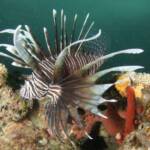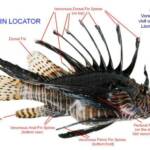


Lionfish (Genus Pterois)
Nothing embodies both the beauty and danger of the ocean more than the lionfish. Not only are they beautiful with their long gracefully flowing fins and dramatic colors, but they come fully equipped with venomous spines capable of delivering painful stings upon any unwary swimmer or diver.
LIONFISH
WANTED
Lionfish
Grief on Our Reef!
The teeth of the red lionfish are numerous, but very tiny. They are placed on the upper and lower jaws in densely packed bilateral clusters and in a small patch on the anterior roof of the mouth. Functionally, these teeth appear to be limited to grasping prey after being captured by their quick predatory strike. They usually swallow their prey whole.
In the U.S., the lionfish have rapidly increased in population from the first reports as little as five years ago. Lionfish may now be as abundant as many native grouper species in the Atlantic Ocean. Although it was first thought the species' northward expansion along the Atlantic coast of the U.S. would be limited by cooler water temperatures, however lionfish have been observed in water as cold as 56 degrees fahrenheit off the southern coast of Long Island, New York.
Website Designed by Tami Beckel for Vone Research, Inc. © 2010. Vone Research is a 501(c)3, non profit organization.
Please report broken links to the Webmaster


Lionfish Fact Sheet
The Pterois volitans, or more commonly known today as red lionfish, have been around since the time of Carolus Linnaeus, a Swedish botanist, physician, and zoologist who laid the foundation for binomial nomenclature. This modern scientific system for naming plants and animals are composed of two Latin names with the first indicating the genus and the second indicating the species.
One of the first scientists Linnaeus met while in his travels to the Netherlands was Johann Frederik Gronovius, a Dutch botanist who helped Linnaeus publish his manuscript as Systema Naturae. The first edition of Systema Naturae was published in 1735. The 10th edition of Systema Naturae was published in two volumes in 1758 and 1759 which marks the starting point of zoological nomenclature. In Systema Naturae the red lionfish are described as Gasterosteus volitans and were later reclassified to Pterois volitans in the 19th century where it remains today.
These species include:
(Click on the drawing above to enlarge the picture or download the PDF file for printing)
A venom gland is located at the base of each spine. After the spine punctures the skin, the venom enters the wound by traveling up a groove in the spine. Lionfish spines are not like hypodermic syringes or pit viper fangs. Instead, a loose integumentary sheath (skin) covers each spine and during envenomation, the sheath is pushed down the spine, causing compression of two venom glands located at the base. The neurotoxic venom then travels from the glands through depressions (grooves) in the wall of the spine and into the puncture wound. There have been at least four toxins identified: an antigenic heat-labile protein which is the primary toxin; acetylcholine (pronunciation: ah-see-toe-coe'-lean) which is a neurotransmitter; a neuromuscular toxin; and a low molecular weight non-proteinaceous ichthyotoxin. There is evidence that commercially available stonefish anti-venom has detoxifying effects on lionfish venom.

The body of most Pterois are dominated by the colors maroon or brown with white stripes along the body and fins. Most scorpionfish are colored to camouflage them against their background, however, the lionfish are a notable exception with their greatly extended fins and striking coloration. The fish of the genus Pterois have a pair of fan-shaped pectoral fins and a spiky first dorsal fin. The dorsal, anal and pelvic fin spines are highly venomous, unlike the pectoral and caudal fins which contain no spines. The 'Fin Locator' drawing below will give you an ideal of the location of these fins and venomous spines.
Pterois is a genus of venomous marine fish found mostly in the Indo-Pacific. Their fins give the appearance of a lion's mane, hence the name lionfish. The shape and coloring of their body provide them with the ability to blend in with their surroundings.
Lionfish inhabit coral reef from about 30 to 165 feet deep. As juveniles lionfish live in small groups, but as adults they typically live alone. Lionfish are a nocturnal species which moves into deeper water at night to forage. The prey of lionfish include smaller coral reef fish and crustaceans, which are swept up and trapped with the extended pectoral fins. Their body is about 1.5 times the length of their head with fleshy tenacles above their eyes and below their mouth. They have cycloid scales that are oval or elliptical in shape with a smooth edge. The anterior part of eacscale is usually overlapped by the posterior portion of the scale in front of it which gives it a greater flexibility than fish with other types of scales.


